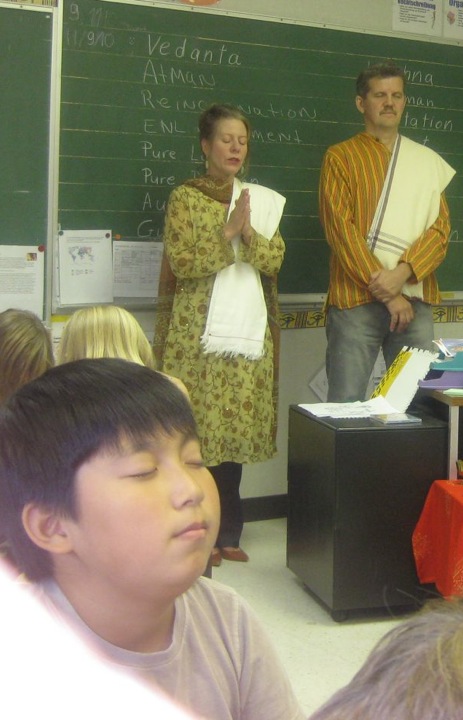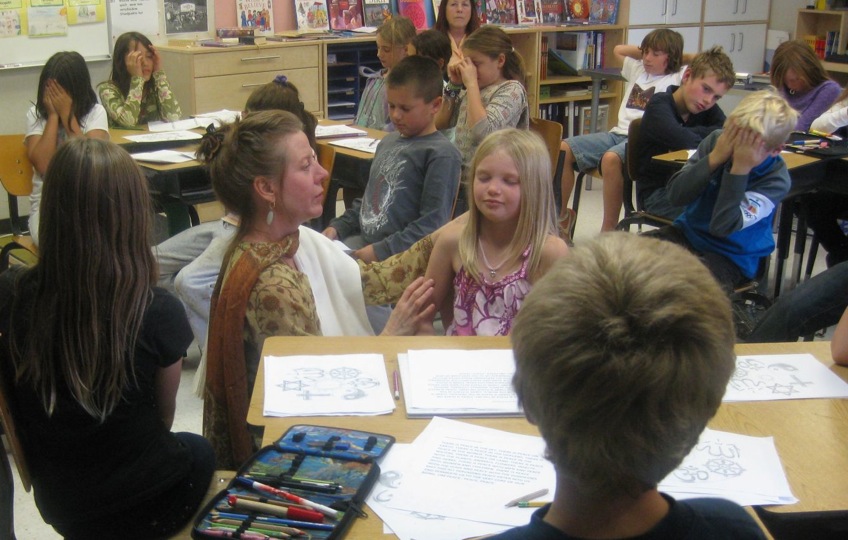A Vedantic Feat
by Bharati
My husband Hansin and I were given a wonderful opportunity last Autumn to present an overview of Vedanta to two 4th grade classes (totaling 27 children) at the German American School in Palo Alto, California. The Fourth Graders there were doing a unit on World Religions and the teachers asked us to participate in the section on Hinduism. Our time slot was for 30 minutes and we ended up speaking for an hour because of the interest of the students and teachers.
How could we refuse to speak on Vedanta? However, did we have the ability to pursue what we thought of as a daunting objective? So we approached our Guru (Babaji) for guidance and received a few instructions and his blessing to move forward. This, combined with our sincere desire to share this beloved path, attendance at the children’s classes at SRV San Francisco, and the understanding that has been developing from our own personal practice, gave us confidence. Besides, sharing the Dharmic path with children is of utmost importance.
Here is the basic structure we used for this class.
We wrote the following words on the board as we knew that we would touch on each one:
Vedanta, Atman, Enlightenment, Reincarnation, Pure Love, Pure Devotion, AUM, Brahman, Meditation, Sanskrit, Mantras, Ganesha, Compassion, Namaste, Guru, Krishna
We created the following hand-outs:
Peace Invocation (from the Yajur Veda), Peace Invocation (from the Rig Veda), Chorus section of “Om Jaya Ganapati” and the wheel that shows the symbols of the world religions. [Listen to Peace Chants]We created one color photo for each of the following:
A beautiful photo of Sri Krishna.
A photo of children meditating
 The Class Begins
The Class Begins
We opened with the Namaste greeting and asked that they greet us back with “Namaste” and folded hands. We introduced ourselves as husband and wife and you could tell they thought that was pretty cool. They liked our names, Bharati and Hansin. We were clear to point out that we were there to present Vedanta. We then led them through a three-minute meditation. They were much more focused and present after this. Next, we explained that before speaking about spiritual things we always start with a Peace Invocation from the Yajur Veda.
Om sahanavavatu sa ha nau bhunaktu
saha viryam karavavahai tejasvi navadhitamastu
ma vidvishavahai Om shantih shantih shantih
May Brahman protect us, may Brahman sustain us,
may Brahman illumine our thinking process. May we not find fault with each other, with our teachers or with the world
and may what we study become a source of inspiration to us, eternally. Om peace, peace, peace.
Hearing 27 children read this out loud was so touching and peaceful. We first led it in Sanskrit and then together in English. We followed this with a little arati ritual at the small Altar we had created and waved incense around the images of the Deities. This set a peaceful atmosphere for the class.
 Next, we introduced the basic history of Vedanta/Hinduism: how it was developed in India thousands of years ago and then was brought to us by a beautiful Swami about 120 years ago. We showed them a picture of Swami Vivekananda and had them repeat his name. They were very good with all of the Sanskrit pronunciations. I let them know that the picture they were looking at was of Swamiji in deep meditation. “Ohhhh,” they said softly. Several of the boys liked the way he was dressed and made mention of it respectfully. I let them know that no other Swami had left India before to share Vedanta but that Swami Vivekananda was determined to share Vedanta with the world.
Next, we introduced the basic history of Vedanta/Hinduism: how it was developed in India thousands of years ago and then was brought to us by a beautiful Swami about 120 years ago. We showed them a picture of Swami Vivekananda and had them repeat his name. They were very good with all of the Sanskrit pronunciations. I let them know that the picture they were looking at was of Swamiji in deep meditation. “Ohhhh,” they said softly. Several of the boys liked the way he was dressed and made mention of it respectfully. I let them know that no other Swami had left India before to share Vedanta but that Swami Vivekananda was determined to share Vedanta with the world.
 We shared that the Vedantist respects all religions of the world because the light of God shines through all of them and they are all paths to God. I had them go to the handout of the World Religions symbols. They loved this handout and knew all of the symbols. They wanted to spend time on each of the symbols and talk about the different religions. “Just imagine the light of God, like a sun, in the middle shining its Light through all of the religions,” I said. One young girl asked if she could draw the sun in the middle to show this and of course I gave a big “yes.”
We shared that the Vedantist respects all religions of the world because the light of God shines through all of them and they are all paths to God. I had them go to the handout of the World Religions symbols. They loved this handout and knew all of the symbols. They wanted to spend time on each of the symbols and talk about the different religions. “Just imagine the light of God, like a sun, in the middle shining its Light through all of the religions,” I said. One young girl asked if she could draw the sun in the middle to show this and of course I gave a big “yes.”
 We talked about the different ways that Vedantists pray:
We talked about the different ways that Vedantists pray:
Prayer Chants, Japa (repetition of the mantra on prayer beads), Hymns (devotional Love songs to God) and Meditation. I showed them my prayer beads and gave an example of how we say our Mantra inside of our mind and roll each bead through our two fingers. They listened with rapt attention. I told them I would not say my personal mantra out loud to them as it is very sacred. One young boy told me that when he is bad in class that his teacher makes him say a mantra, “I will learn my lesson well,” and that he has to repeat it over and over again. I told him that he is not bad and that his teacher has him say that “mantra” so that he will get focused again. He liked and accepted this explanation. The one example I gave was a prayer of peace to the universe while rolling each bead. “Can you imagine,” I asked, “if each person on earth did this how peaceful we all would be?” All 27 children answered with a long drawn out “yes” in unison.
 The Four Yogas
The Four Yogas
The Vedantist must practice the four yogas. When I said the word “yoga” I asked if they thought I was talking about the exercise yoga and they all answered with a big “YES” and even laughed. I went on to explain about Bhakti Yoga – Devotion (through ritual, prayer, and worship), Jnana Yoga – Knowledge (study of the scriptures), Karma Yoga – Work (selfless service) and Raja Yoga – Meditation. One young boy was especially interested in Karma Yoga. It seemed they still had a hard time in relating to any other Yoga than the Hatha Yoga that their mothers do at home.
We told the children that one of the main names we use for God is Brahman, but that in India there are 108 names for God (and even a 1000 names). Their initial reaction was “Wow, that is a lot of names!” We also explained that we refer to God as the Divine Mother too.
God has Form and is Formless too
The Upanishads and the Bhagavad Gita are two of the most important holy books in India. The Vedantist believes God dwells in all living beings and all things. This means that God is inside each of us. Atman is the Sanskrit word for Soul. The Atman is ever pure. It is not born and will never die. It cannot be stained or hurt. The Atman is God’s Light. Here, we went on to explain that we can see God in form and God without form. One young boy yelled out that God is in Heaven too. “Yes,” I said, “but God is also beyond Heaven. There is something more beautiful beyond Heaven.” He said that was scary. “It is really beautiful,” I assured him, “not scary at all.”
At this point we moved to talking about God with form. I showed them a picture of Lord Krishna and explained that many believe that He is God in form. One young girl became animated and said, “Oh, I have a picture of Krishna when he was a baby,” and she showed me a picture of him in a book that she got from the school library.
 We continued our explanation on how God has many aspects and shines His light through the many gods and goddesses. At this point, I showed them the deity Ganesh. One young boy had a book on Ganesh the Elephant God. He was also most intrigued with Sri Krishna. The children related instantly to God in form.
We continued our explanation on how God has many aspects and shines His light through the many gods and goddesses. At this point, I showed them the deity Ganesh. One young boy had a book on Ganesh the Elephant God. He was also most intrigued with Sri Krishna. The children related instantly to God in form.
We then moved on to the more complex topic of God without form. “Think of God as an abundant Light and not a form. Imagine the light of millions of suns. Okay, now see this inside of you.” All were very quiet and then said, “Wow, that is a lot of suns!” I had to explain again that they only see the light and not the actual sun… They wanted to talk about God in form again.
We sang the devotional song “Om Jaya Ganapati. I shared with them that our Guru would be singing the song. They all said “wow!” Many of the children listened very carefully to Loke’s English interpretation of the song and made comments to each other about Ganesh. They wanted to talk at length about the gods and goddesses. I also explained that we are all gods and goddesses and they really liked that idea. One young boy blurted out, “That is why we have to be nice to the girls.” I explained that in reality God is one but appears in different forms. So you see we are ALL connected by the same Light.
One of the many highlights of the presentation was a spiritual discussion with four of the boys for several minutes. One young girl wanted to stand near me after class and when I noticed her she asked, “God is everywhere?” “Yes,” I said, “and also inside of you. You are Divine!” She beamed when she heard this, her face lit up and she was shining.
We ended with the Peace Invocation (from the Rig Veda):
Om dyauhu shantih antariksham shantih
prithivi shantih apaha shantih
oshadayah shantih vanashpatayah shantih
vishvedevah shantih brahma shantih sarvam shantih
shantir eva shantih sa ma shantir edhi
Om shantih shantih shantih
There is peace in the sky, there is peace on earth. There is peace in the heavens, there is peace in the world. There is peace in the waters, there is peace on land. There is peace with the plants, animals, flowers, insects and herbs. There is peace with men and peace with women and children. There is peace with the Gods and peace with the Goddesses. May this all-pervading peace enter into us and permeate us to the very core of our being.
Om peace, peace, peace.
 Question, Questions, Questions
Question, Questions, Questions
After the class they were all drawn to Hansin and I with so many more questions. Several were hovering over the altar. One young boy told me that he has an altar at home with a few of the same Deities. He was not Indian. They flocked to us as if we were a magnet.
Here are a few of their many questions that were asked throughout the entire presentation.
Keep in mind that I had to answer all of these questions but there were many, many more than what I have listed below.
If God is in everything then you can’t eat meat right? (This came to this young boy as a sudden realization.) What is a Guru?
What is a Guru?
Why is Krishna Blue?
So, the whole Universe is in Ganesha’s belly?
Do you fast?
Do the Vedantists treat girls in a nice way?
Are they mean to girls in India?
Are all the Swamis boys?
Are there any girl Swamis?
How many Gods do you have?
Can you also talk the Hymns or do you have to sing them? Do you know all the Holy books by heart?
Do you know all the Holy books by heart?
Do you speak Hindu?
Do you know all the prayers by heart?
How often do you pray?
Do you have to do Jnana Yoga everyday?
How often do you meditate?
Is it okay to make fun of somebody?
What is Aum? (This young boy was very intrigued with Aum.)
The Vedanta presentation was a Vedantic success. It was truly amazing in many ways! I am not sure if I have ever had such a fulfilling experience. The children and the teachers did not seem to want it to end. The teachers told us that we were the first speakers on Hinduism that they have ever had at the school. Others that they asked simply said no. Hansin felt that we were a good team and we would very much enjoy doing this again.
